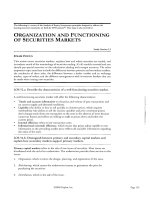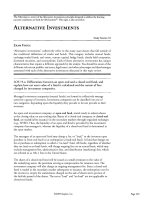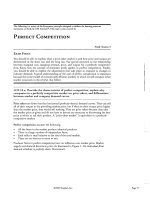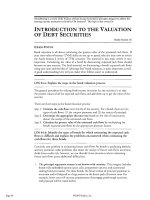CFA level 1 formula sheets sample
Bạn đang xem bản rút gọn của tài liệu. Xem và tải ngay bản đầy đủ của tài liệu tại đây (136.5 KB, 6 trang )
2016
CFA® EXAM REVIEW
COVERS
ALL TOPICS
IN LEVEL I
LEVEL I CFA
®
FORMULA SHEETS
Copyright © 2016 by John Wiley & Sons, Inc. All rights reserved.
Published by John Wiley & Sons, Inc., Hoboken, New Jersey.
Published simultaneously in Canada.
No part of this publication may be reproduced, stored in a retrieval system, or transmitted in any
form or by any means, electronic, mechanical, photocopying, recording, scanning, or otherwise,
except as permitted under Section 107 or 108 of the 1976 United States Copyright Act, without
either the prior written permission of the Publisher, or authorization through payment of the
appropriate per-copy fee to the Copyright Clearance Center, Inc., 222 Rosewood Drive, Danvers,
MA 01923, (978) 750-8400, fax (978) 646-8600, or on the Web at www.copyright.com. Requests
to the Publisher for permission should be addressed to the Permissions Department, John Wiley &
Sons, Inc., 111 River Street, Hoboken, NJ 07030, (201) 748-6011, fax (201) 748-6008, or online
at />Limit of Liability/Disclaimer of Warranty: While the publisher and author have used their best
efforts in preparing this book, they make no representations or warranties with respect to the
accuracy or completeness of the contents of this book and specifically disclaim any implied
warranties of merchantability or fitness for a particular purpose. No warranty may be created or
extended by sales representatives or written sales materials. The advice and strategies contained
herein may not be suitable for your situation. You should consult with a professional where
appropriate. Neither the publisher nor author shall be liable for any loss of profit or any other
commercial damages, including but not limited to special, incidental, consequential, or other
damages.
For general information on our other products and services or for technical support, please contact
our Customer Care Department within the United States at (800) 762-2974, outside the United
States at (317) 572-3993 or fax (317) 572-4002.
Wiley publishes in a variety of print and electronic formats and by print-on-demand. Some
material included with standard print versions of this book may not be included in e-books or in
print-on-demand. If this book refers to media such as a CD or DVD that is not included in the
version you purchased, you may download this material at . For
more information about Wiley products, visit www.wiley.com.
Financial Analysis Techniques
Financial Analysis Techniques
Inventory Turnover
Inventory turnover =
Cost of goods sold
Average inventory
Days of Inventory on Hand
Days of inventory on hand (DOH) =
365
Inventory turnover
Receivables Turnover
Receivables turnover =
Revenue
Average receivables
Days of Sales Outstanding
Days of sales outstanding (DSO) =
365
Receivables turnover
Payables Turnover
Payables turnover =
Purchases
Average trade payables
Number of Days of Payables
Number of days of payables =
365
Payables turnover
Working Capital Turnover
Working capital turnover =
Revenue
Average working capital
Fixed Asset Turnover
Fixed asset turnover =
Revenue
Average fixed assets
Total Asset Turnover
Total asset turnover =
46
Revenue
Average total assets
© Wiley 2016 All Rights Reserved. Any unauthorized copying or distribution will constitute an infringement of copyright.
Financial Analysis Techniques
Current Ratio
Current ratio =
Current assets
Current liabilities
Quick Ratio
Quick ratio =
Cash + Short-term marketable investments + Receivables
Current liabilities
Cash Ratio
Cash ratio =
Cash + Short-term marketable investments
Current liabilities
Defensive Interval Ratio
Defensive interval ratio =
Cash + Short-term marketable investments + Receivables
Daily cash expenditures
Cash Conversion Cycle
Cash conversion cycle = DSO + DOH − Number of days of payables
Debt‐to‐Assets Ratio
Debt -to-assets ratio =
Total debt
Total assets
Debt‐to‐Capital Ratio
Debt -to-capital ratio =
Total debt
Total debt + Shareholders’ equity
Debt‐to‐Equity Ratio
Debt -to-equity ratio =
Total debt
Shareholders’ equity
Financial Leverage Ratio
Financial leverage ratio =
Average total assets
Average total equity
Interest Coverage Ratio
Interest coverage ratio =
EBIT
Interest payments
© Wiley 2016 All Rights Reserved. Any unauthorized copying or distribution will constitute an infringement of copyright.
47
Financial Analysis Techniques
Fixed Charge Coverage Ratio
Fixed charge coverage ratio =
EBIT + Lease payments
Interest payments + Lease payments
Gross Profit Margin
Gross profit margin =
Gross profit
Revenue
Operating Profit Margin
Operating profit margin =
Operating profit
Revenue
Pretax Margin
Pretax margin =
EBT (earnings before tax, but after interest)
Revenue
Net Profit Margin
Net profit margin =
Net profit
Revenue
Return on Assets
ROA =
Net income
Average total assets
Adjusted ROA =
Net income + Interest expense (1 − Tax rate)
Average total assets
Operating ROA =
Operating income or EBIT
Average total assets
Return on Total Capital
Return on total capital =
EBIT
Short-term debt + Long-term debt + Equity
Return on Equity
Return on equity =
Net income
Average total equity
Return on Common Equity
Return on common equity =
48
Net income − Preferred dividends
Average common equity
© Wiley 2016 All Rights Reserved. Any unauthorized copying or distribution will constitute an infringement of copyright.
Financial Analysis Techniques
DuPont Decomposition of ROE
Net income
Average shareholders’ equity
ROE =
2‐Way Dupont Decomposition
Net income
Average total assets
×
Average total assets Average shareholders’ equity
ROE =
↓
↓
ROA
Leverage
3‐Way Dupont Decomposition
Net income
Average total assets
Revenue
×
×
Revenue
Average total assets Average shareholders’ equity
ROE =
↓
↓
Net profit margin
↓
Asset turnover
Leverage
5‐Way Dupont Decomposition
ROE =
Interest burden
Asset turnover
↓
↓
Net income EBT
Average total assets
EBIT
Revenue
×
×
×
×
EBT
EBIT Revenue Average total assets Avg. shareholders’ equity
↓
↓
↓
Tax burden
EBIT margin
Leverage
Price‐to‐Earnings Ratio
P /E =
Price per share
Earnings per share
Price to Cash Flow
P /CE =
Price per share
Cash flow per share
Price to Sales
P /S =
Price per share
Sales per share
Price to Book Value
P /BV =
Price per share
Book value per share
© Wiley 2016 All Rights Reserved. Any unauthorized copying or distribution will constitute an infringement of copyright.
49









